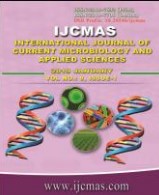


 National Academy of Agricultural Sciences (NAAS)
National Academy of Agricultural Sciences (NAAS)

|
PRINT ISSN : 2319-7692
Online ISSN : 2319-7706 Issues : 12 per year Publisher : Excellent Publishers Email : editorijcmas@gmail.com / submit@ijcmas.com Editor-in-chief: Dr.M.Prakash Index Copernicus ICV 2018: 95.39 NAAS RATING 2020: 5.38 |
Maize, Zea mays L., is one of the important cereal crops with diverse uses as food, feed, fodder and industrial applications. As a food crop it is a primary source of nourishment to people in Africa, Latin America and South Asia. It is also the principal energy source used in poultry diets in most of the countries including India because of its high-energy value, palatability, presence of pigments and essential fatty acids. Yellow kernelled cultivars are preferred as poultry feed as it is a rich source of β-carotenes and xanthophylls conferring yellow colour for colouration of egg yolk, poultry fat and skin. Maize also contains highest amount of energy among cereal grains and has high TDN of 85-90%. By virtue of these advantages, maize is known as nutri-cereal. It is however, deficient in two essential amino acids namely lysine and tryptophan but with the discovery of opaque mutants, these deficiencies were overcome through the breeding of opaque varieties which later paved way to the development of Quality Protein Maize (QPM). The nutritionally enriched QPM kernels contain double the quantity of lysine and tryptophan, balanced ratio of isoleucine to leucine and increased desirable proteins viz. albumins, glutelins and globulins in their endosperm. With its development, new vistas were opened up for achieving food and nutrition security of the under-privileged masses. In this mini-review, role of yellow maize in general and QPM in particular in augmenting food, feed and nutrition security especially in Indian context is discussed.
 |
 |
 |
 |
 |